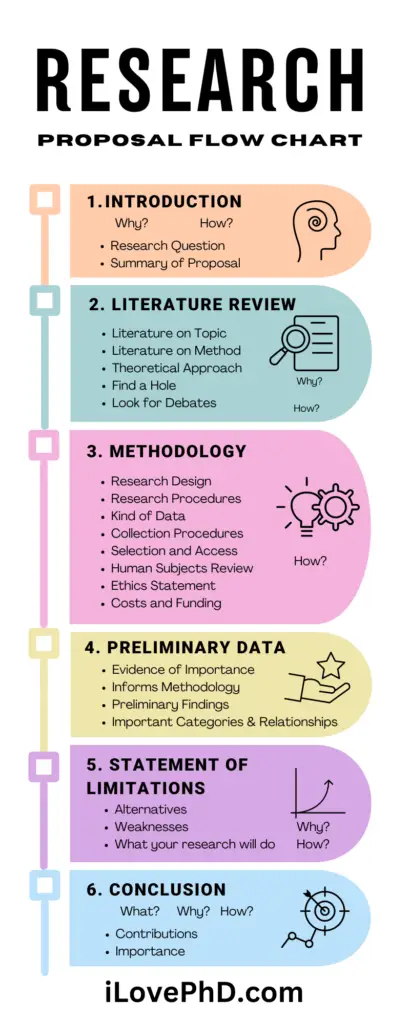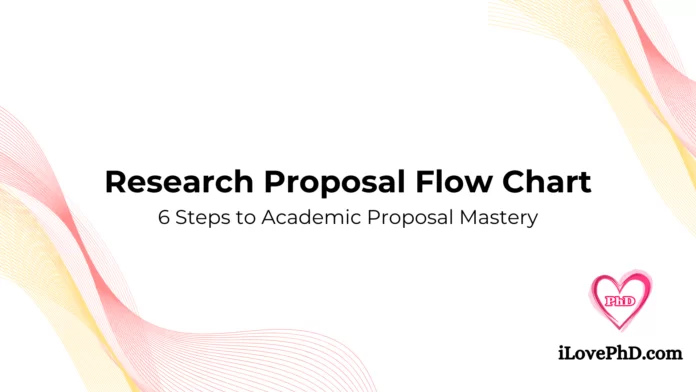In the world of academia, crafting a compelling research proposal is a crucial skill that can make or break your project’s success. Whether you’re a seasoned researcher or a budding scholar, understanding the structure and flow of a well-crafted proposal is essential. Today, we’re diving deep into the Research Proposal Flow Chart, a powerful tool that can guide you through the intricate process of proposal writing.
The Research Proposal Flow Chart: A Visual Roadmap
The Research Proposal Flow Chart is a visual representation of the key components that make up a comprehensive research proposal. This chart outlines six main stages, each with its crucial elements. Let’s break down each stage and explore why it’s vital to your proposal’s success.

1. Introduction: The Foundation of Your Proposal
The introduction is where you set the stage for your entire research project. According to our Research Proposal Flow Chart, this section should address three fundamental questions:
- What is your research about?
- Why is it important?
- How do you plan to conduct the research?
The introduction should include your research question and a summary of the proposal. This gives your readers a clear roadmap of what to expect and why they should care about your research.
Key elements:
- Research Question
- Summary of Proposal
Pro tip: Make your introduction compelling and concise. It’s your chance to hook the reader and demonstrate the value of your research.
2. Literature Review: Contextualizing Your Work
The literature review is crucial for situating your research within the existing body of knowledge. The Research Proposal Flow Chart highlights four key aspects of this section:
- Literature on Topic
- Literature on Method
- Finding a Hole (in existing research)
- Looking for Debates
This section demonstrates your thorough understanding of the field and justifies the need for your proposed research. It’s not just about summarizing existing work; it’s about critically analyzing it to show where your research fits in.
Key elements:
- Comprehensive review of relevant literature
- Identification of research gaps
- Analysis of ongoing debates in the field
Pro tip: Use the literature review to build a strong case for why your research is necessary and how it will contribute to the field.
3. Methodology: The Blueprint of Your Study
The methodology section is the heart of your research proposal. It outlines how you plan to conduct your study and collect data. The Research Proposal Flow Chart breaks this down into several crucial components:
- Research Design
- Research Procedures
- Kind of Data
- Collection Procedures
- Selection and Access
- Human Subjects Review
- Ethics Statement
- Costs and Funding
This section should be detailed enough that another researcher could potentially replicate your study. It’s where you demonstrate the feasibility and rigor of your proposed research.
Key elements:
- Detailed description of research methods
- Explanation of data collection and analysis procedures
- Consideration of ethical implications
- Budget and funding information
Pro tip: Be as specific as possible in your methodology. This builds credibility and shows that you’ve thought through the practical aspects of your research.
4. Preliminary Data: Building a Strong Foundation
If you have preliminary data, this section can significantly strengthen your proposal. The Research Proposal Flow Chart highlights the importance of this section for:
- Showing Evidence of Importance
- Informing Methodology
- Presenting Preliminary Findings
- Identifying Important Categories & Relationships
Preliminary data can demonstrate the feasibility of your research and provide early insights into your topic.
Key elements:
- Initial findings from pilot studies or preliminary research
- Explanation of how preliminary data informs your main study
- Identification of emerging patterns or relationships in the data
Pro tip: Use visuals like charts or graphs to present your preliminary data effectively.
5. Statement of Limitations: Acknowledging Boundaries
Every research project has limitations, and it’s crucial to address them proactively. The Research Proposal Flow Chart emphasizes two main aspects:
- Alternatives
- Weaknesses
This section demonstrates your critical thinking skills and shows that you’ve considered potential challenges to your research.
Key elements:
- Discussion of potential weaknesses in your research design
- Explanation of what your research will and won’t be able to accomplish
- Consideration of alternative approaches
Pro tip: Frame limitations as opportunities for future research to show the long-term potential of your work.
6. Conclusion: Tying It All Together
The conclusion is your final opportunity to make a lasting impression. The Research Proposal Flow Chart highlights three key elements:
- Contributions
- Importance
- What? How? Why?
Use this section to summarize your proposal’s key points, reiterate the importance of your research, and explain how your study will contribute to the field.
Key elements:
- Summary of main points
- Reiteration of research significance
- Clear statement of expected contributions to the field
Pro tip: End with a strong statement that leaves the reader convinced of your project’s value and eager to see the results.
Conclusion: The Power of the Research Proposal Flow Chart
By following the Research Proposal Flow Chart, you can ensure that your proposal is comprehensive, well-structured, and compelling. This visual guide serves as a roadmap for crafting a proposal that not only meets academic standards but also effectively communicates the value and potential impact of your research.
Remember, a well-crafted research proposal is more than just a requirement—it’s a powerful tool for securing funding, gaining institutional support, and setting the stage for successful research. By mastering the art of proposal writing with the help of the Research Proposal Flow Chart, you’re taking a significant step toward academic and research excellence.
Whether you’re proposing a groundbreaking study or contributing to an established field, let the Research Proposal Flow Chart be your guide to creating a proposal that stands out and gets results.
Also Read: Research Proposal with Example | How to Write a Good Research Proposal?

